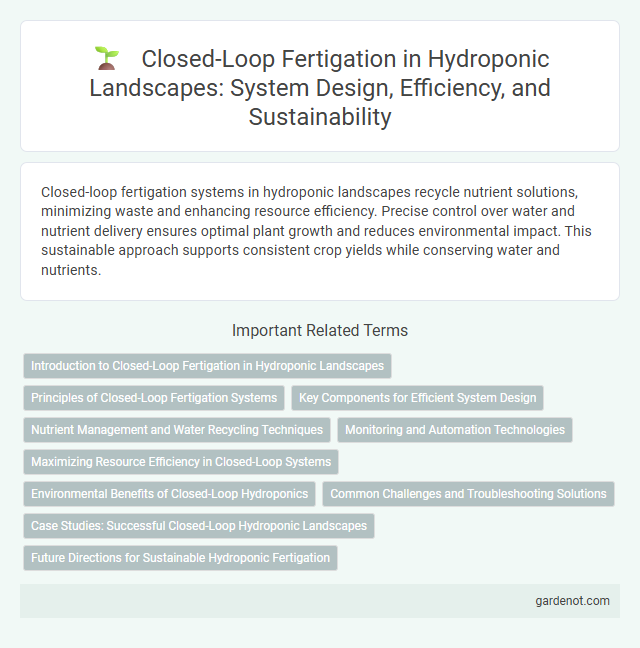Closed-loop fertigation systems in hydroponic landscapes recycle nutrient solutions, minimizing waste and enhancing resource efficiency. Precise control over water and nutrient delivery ensures optimal plant growth and reduces environmental impact. This sustainable approach supports consistent crop yields while conserving water and nutrients.
Introduction to Closed-Loop Fertigation in Hydroponic Landscapes
Closed-loop fertigation in hydroponic landscapes combines precise nutrient delivery with water recycling to enhance plant growth and resource efficiency. This system captures, filters, and reuses runoff water enriched with nutrients, minimizing waste and reducing environmental impact. By continuously monitoring nutrient levels and adjusting inputs, closed-loop fertigation ensures optimal plant health and sustainable cultivation practices.
Principles of Closed-Loop Fertigation Systems
Closed-loop fertigation systems recycle nutrient-rich runoff water by recapturing and filtering it to maintain optimal nutrient balance, reducing water and fertilizer waste. Sensors continuously monitor pH, electrical conductivity (EC), and nutrient concentration to adjust inputs in real-time, ensuring precise nutrient delivery tailored to plant growth stages. This sustainable approach enhances resource efficiency, minimizes environmental impact, and supports consistent crop quality in hydroponic landscapes.
Key Components for Efficient System Design
Closed-loop fertigation in hydroponic landscapes relies on precise nutrient dosing pumps, automated sensors for real-time monitoring of pH and electrical conductivity, and recirculation tanks to minimize water and nutrient waste. Essential components also include filtration units to prevent clogging and ensure a clean nutrient solution, as well as control systems for adjusting flow rates and nutrient concentrations dynamically. Integrating these key elements enhances system efficiency, reduces operational costs, and promotes sustainable crop growth.
Nutrient Management and Water Recycling Techniques
Closed-loop fertigation in hydroponic landscapes maximizes nutrient efficiency by continuously recycling nutrient solutions, minimizing waste and reducing environmental impact. Advanced water recycling techniques, such as filtration and UV sterilization, ensure water quality is maintained for optimal plant growth and prevent pathogen buildup. Precise nutrient management systems leverage real-time sensors and automation to adjust nutrient concentrations, promoting sustainable resource use and improving crop yield consistency.
Monitoring and Automation Technologies
Closed-loop fertigation systems in hydroponic landscapes leverage advanced monitoring and automation technologies to optimize nutrient delivery and water use efficiency. Real-time sensors track pH, EC (electrical conductivity), and moisture levels, enabling precise adjustments to nutrient concentration and irrigation schedules. Automated control units integrate data analytics and IoT connectivity to maintain an ideal growing environment, reducing waste and enhancing crop yield consistency.
Maximizing Resource Efficiency in Closed-Loop Systems
Closed-loop fertigation systems in hydroponic landscapes maximize resource efficiency by recycling nutrient solutions, reducing water consumption by up to 90% compared to traditional methods. Precision monitoring and automated nutrient adjustments optimize plant uptake, minimizing waste and environmental impact. These systems enhance sustainability by maintaining nutrient balance, preventing leaching, and promoting consistent crop yields in controlled environments.
Environmental Benefits of Closed-Loop Hydroponics
Closed-loop hydroponics systems significantly reduce water consumption by recycling nutrient solutions, minimizing waste and preventing nutrient runoff into surrounding ecosystems. This method enhances nutrient use efficiency, lowering fertilizer requirements and decreasing chemical pollution. As a result, closed-loop fertigation promotes sustainable agriculture by conserving resources and reducing the environmental footprint of hydroponic landscapes.
Common Challenges and Troubleshooting Solutions
Closed-loop fertigation systems in hydroponic landscapes often face challenges such as nutrient imbalances, pH fluctuations, and system clogging due to salt buildup or biofilm formation. Regular monitoring of nutrient concentrations using EC meters and pH sensors, combined with periodic flushing and cleaning of fertigation lines, helps maintain optimal solution quality. Implementing automated dosing systems and real-time data analytics enhances troubleshooting efficiency by quickly identifying and correcting deviations in nutrient delivery.
Case Studies: Successful Closed-Loop Hydroponic Landscapes
Case studies on closed-loop hydroponic landscapes demonstrate significant water and nutrient use efficiency, reducing waste by up to 90% compared to traditional methods. Successful implementations in urban farming projects highlight consistent crop yields with minimal environmental impact, utilizing real-time sensor data to optimize nutrient recirculation. These examples confirm the viability of closed-loop fertigation systems in sustainable, high-density horticulture environments.
Future Directions for Sustainable Hydroponic Fertigation
Closed-loop fertigation systems in hydroponic landscapes optimize nutrient recycling by continuously recirculating water and nutrients, significantly reducing waste and environmental impact. Future directions emphasize integrating smart sensors and AI-driven analytics to enhance precision nutrient delivery and real-time monitoring, improving crop yield and resource efficiency. Innovations in biodegradable nutrient reservoirs and renewable energy-powered systems will further promote sustainability in hydroponic fertigation practices.
Closed-loop fertigation Infographic

 gardenot.com
gardenot.com